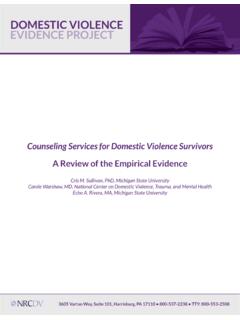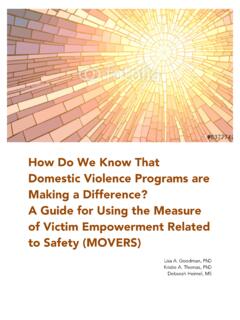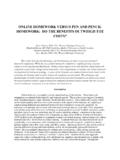Transcription of Counseling Services for Domestic Violence Survivors …
1 3605 Vartan Way, Suite 101, Harrisburg, PA 17110 800-537-2238 TTY: 800-553-2508 Counseling Services for Domestic Violence SurvivorsA Review of the Empirical Evidence Cris M. Sullivan, PhD, Michigan State UniversityCarole Warshaw, MD, National Center on Domestic Violence , Trauma, and Mental HealthEcho A. Rivera, MA, Michigan State UniversityCounseling Services for Domestic Violence Survivors : A Review of the Empirical Evidence - of 10 Distribution Rights. This DV Evidence Project paper may be reprinted in its entirety or excerpted with proper acknowledgement to the author(s) and the National Resource Center on Domestic Violence , but may not be altered or sold for Citation. Sullivan, , Warshaw, C., & Rivera, E. (2013, October). Counseling Services for Domestic Violence Survivors , Harrisburg, PA: National Resource Center on Domestic Violence . Retrieved month/day year, from: Copyright 2013. National Resource Center on Domestic Violence . All rights OF THE DV EVIDENCE PROJECTI ncreasingly, Domestic Violence programs are being asked to learn more about, contribute to, and describe how they are engaging in evidence-based and evidence-informed practices.
2 Funders, policymakers, researchers, and advocates themselves are also more interested today in what evidence exists that a particular intervention or prevention strategy is making a positive difference for Survivors , or is meeting the outcomes it was designed to achieve. With this information, Domestic Violence programs can better secure continued support for proven programs and practices, and can more easily identify, develop, and/or adapt innovative or exemplary approaches from other communities. To respond to this new emphasis on evidence-based and evidence-informed practice, the National Resource Center on Domestic Violence (NRCDV), with support and direction from the Family Violence Prevention and Services Program at the Department of Health and Human Services , engaged in a two-pronged approach. First, evidence was collected and synthesized from published, empirical research studies. Second, in recognition that controlled research studies are not the only form of evidence to consider in determining program effectiveness (Puddy & Wilkins, 2011; Schorr & Farrow, 2011), the project also identified where emerging and promising evidence exists that specific programs and practices are effectively addressing complex social problems in community settings.
3 This research summary, one of a series developed by the NRCDV s Domestic Violence Evidence Project, should be viewed as an important piece of information to consider, but it does not include the broad scope and continuum of Services being delivered across the country or globe. Practice-based evidence being generated by the field and captured in the project s Program and Practice Profiles should also be considered. In one field after another, we are learning that so much of the most promising work in addressing the most intractable social problems is complex, multifaceted, and evolving. Schorr & Farrow, 2011; p. 22 Counseling Services for Domestic Violence Survivors : A Review of the Empirical Evidence - of 10 Counseling Services for Domestic Violence Survivors A Review of the Empirical EvidenceIntroductionMany Domestic Violence victim service programs offer Counseling as one of their core Services . Counseling is a broad term, defined by the American Counseling Association as a professional relationship that empowers diverse individuals, families, and groups to accomplish mental health, wellness, education, and career goals (ACA Governing Council, 2010).
4 As such, this term includes Counseling offered by non-degreed practitioners with crisis intervention and support training (often referred to as peer counselors), as well as degreed practitioners with formal training in using therapeutic techniques to facilitate healing. Regardless of how it is delivered and by whom, Counseling offered within Domestic Violence programs typically involves helping Survivors recover their personal sense of power and control. It is also one way through which Survivors learn about common emotional and behavioral responses to Domestic abuse. Counseling Services offered by Domestic Violence programs incorporate a variety of therapeutic approaches ( , cognitive-behavioral, solution-focused, empowerment-based, art therapy) tailored to the individual needs and desires of Survivors . Some programs offer individual Counseling , some provide group Counseling , and still others offer both (Howard, Riger, Campbell, & Wasco, 2003). The general intent behind Counseling interventions is to alleviate the distress that often accompanies victimization ( , depression, anxiety, posttraumatic stress symptoms, guilt, shame) and to increase Survivors sense of self and well-being.
5 The purpose of this review was to systematically locate and review the empirical evidence behind providing Counseling Services to Survivors of intimate partner Violence (IPV) within or in collaboration with Domestic Violence programs. MethodThis systematic evidence review involved three components. First, we searched for potential programs and treatments using national registries of evidence-based practices (Campbell Collaboration, Canadian Best Practices Portal, Blueprints for Violence Prevention, Cochrane Reviews, Community Guide, Evidence for Policy & Practice Information & Coordinating Center, Home Visiting Evidence of Effectiveness, Crime Solutions, Promising Practices Network on Children, Families, and Communities, Coalition for Evidence-Based Policy Social Programs That Work, and the National Registry of Evidence Based Programs and Practices). The keywords abuse, Domestic Violence , intimate partner Violence , interpersonal Violence , Counseling , effectiveness, evaluation, longitudinal, intervention, randomized, control group and Services or intervention were used in combination for each registry that had search functions.
6 In those cases where the registry did not have a search function, we browsed the provided categories for programs. Second, empirical studies were located using ProQuest (PsycINFO, PsycARTICLES, PILOTS, ProQuest Psychology Journals, and ProQuest Research Library), PubMed, and Web of Science scientific databases, and the same combination of keywords. Results were limited to peer-reviewed, empirical articles published after 1980 and written in English. Third, additional articles were located using a backward search through relevant articles. The Counseling Services for Domestic Violence Survivors : A Review of the Empirical Evidence - of 10focus of the review was to identify Counseling interventions that: (1) specifically targeted adult Survivors of IPV; (2) were provided within or in collaboration with Domestic Violence programs; and (3) included comparison or control groups to examine treatment impact. The original search yielded 13,945 results, but the vast majority of these were not empirical articles that fit the review criteria.
7 Six articles met the inclusion criteria for this of the six articles included in this review evaluated Counseling Services that included cognitive behavioral therapy (CBT). CBT is a broad term that encompasses a variety of short-term treatments that include both cognitive techniques (such as learning to think about something differently) and behavioral components (education and skill-building to put new thoughts into practice). It is typically delivered by psychologists, social workers, counselors or nurses who have received training in this particular method, and it can be provided in office settings, Domestic Violence programs, or other community-based agencies. The therapy is generally offered once a week for a few weeks to several months, and involves homework to put new concepts and skills into practice. When used with trauma victims, it sometimes includes prolonged exposure, or recalling and discussing the traumatic event in order to reduce the emotional response to it (Foa et al.)
8 , 2005), although this technique is controversial given the concern that such recall may exacerbate, rather than reduce, trauma symptoms (Cloitre, Koenen, Cohen, & Han, 2002). Johnson and colleagues (2011) created a CBT program specifically for women residing temporarily in Domestic Violence shelters, which they named HOPE: Helping to Overcome PTSD through Empowerment. HOPE involves 9-12, twice-a-week, 60-90 minute individual sessions (over a maximum of eight weeks) that address issues especially salient to abused women. Based heavily on Herman s (1992) multi-stage model of recovery, it involves three stages: (1) re-establishing safety and a sense of self-care; (2) remembering and mourning; and (3) reconnection. The treatment prioritizes women s safety needs, does not include exposure therapy, and focuses heavily on women s empowerment. Specifically, therapists focus on women s individual needs and choices, and help them develop any skills needed to reach their personal goals.
9 Later sessions focus on building cognitive and behavioral skills to manage posttraumatic stress disorder (PTSD) symptoms and triggers, while optional modules are available that address common co-occurring issues such as substance abuse and managing grief. Women were eligible for this study if they met subthreshold PTSD criteria, which means they did not meet the full clinical diagnosis for PTSD, but were re-experiencing the traumatic event ( , through flashbacks) and were also either avoiding reminders of the abuse or were experiencing hyperarousal ( , easily startled). Symptoms had to have persisted for at least 30 days, and causing women significant distress. Additional inclusion criteria included: This paper was prepared for the Domestic Violence Evidence Project, an initiative of the National Resource Center on Domestic Violence . The overall goal of the DV Evidence Project is to combine what we know from research, evaluation, practice and theory to inform critical decision-making related to Domestic Violence intervention and prevention efforts.
10 We encourage you to visit for additional materials, including research summaries, community practice summaries and evaluation Services for Domestic Violence Survivors : A Review of the Empirical Evidence - of 10(1) no diagnosis of bipolar disorder or psychosis; (2) not concurrently in individual therapy; (3) no changes in psychotropic medications over the prior 30 days; and (4) no significant suicide ideation or risk. The six therapists who provided the treatment had either doctorates or master s degrees in psychology or Counseling , and had at least one year s experience conducting IPV Survivors were randomized to either receive HOPE or to continue receiving standard shelter Services . Shelter Services included case management and support groups but no therapy or Counseling Services . All women were then re-interviewed 1 week, 3 months and 6 months after they left shelter. A number of positive findings were reported from this study. Compared to women in the control condition, those in the HOPE condition were less likely to experience abuse six months after leaving shelter.






